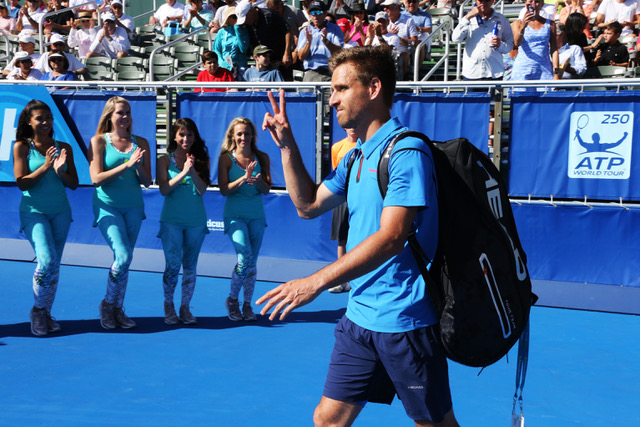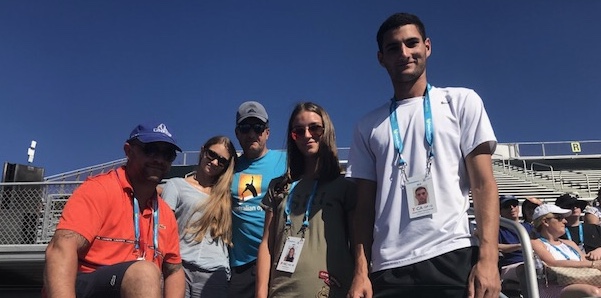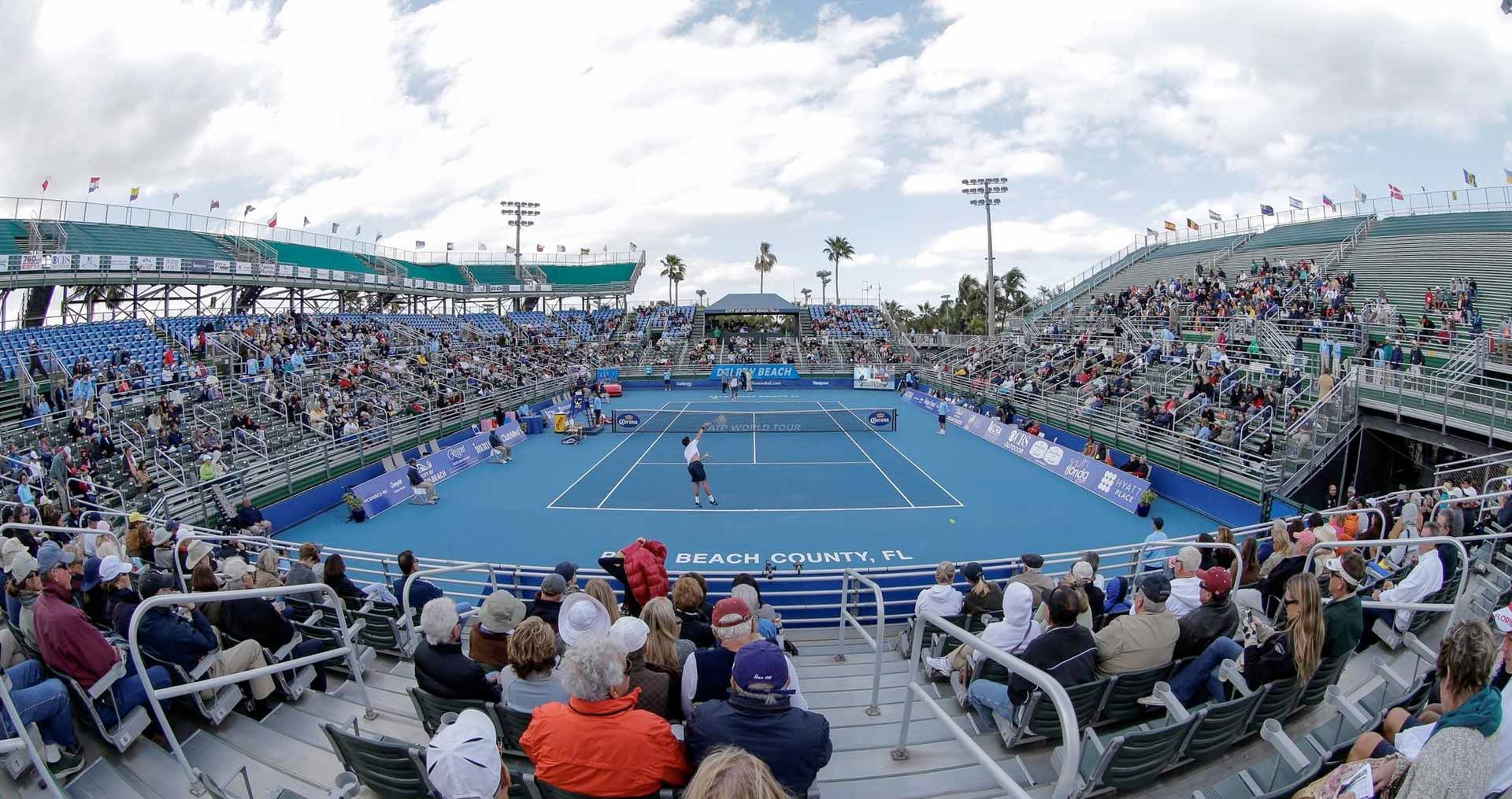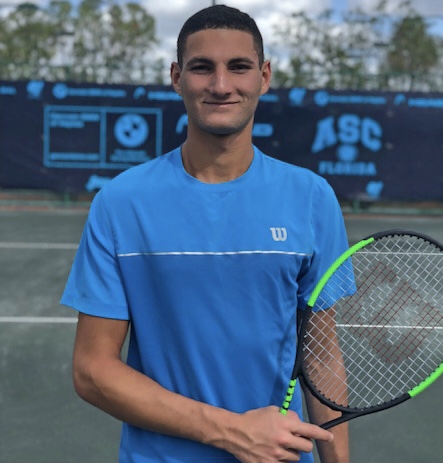
By Cameron Mofid, Student-Athlete at Academia Sanchez-Casal Florida
A top-ranked tennis professional, although alone on court, is supported by a variety of experts: at the very least, an ATP or WTA player usually travels with a tennis coach, a physiotherapist, and a fitness trainer. However, on championship Sunday of the 2018 Delray Beach Open, 64th world-ranked German Peter Gojowczyk was supported by a much more unpredictable team: I (who had just met Peter 10 days prior to that Sunday), along with an old friend of Peter’s from 11 years prior and his friend’s daughter were the ones accompanying him. In hindsight, perhaps the unforeseen makeup of his player’s box that day was representative of his surprising run to the final that week.
As a tournament intern, I mainly worked in the credential office to ensure that staff, guests, and players received their official identification badges. The office maintained a hectic and lively vibe due to the volume of work. As mentioned, just one professional player could mean five or six additional credentials for his/her whole team.
This usually active environment made Peter’s arrival all the more interesting, as he traveled to the tournament alone, just with his belongings and racquets. Surprised and inquisitive about his party of one, I offered to train with him the following afternoon and to my amazement, we set up a 1 p.m. court time for the next day.
Although I worried about not being high-level enough to meet his practice standards, I told myself to maintain a positive attitude and make as many balls in the court as possible. Peter was more than welcoming and found ways to make the training both efficient and enjoyable. We utilized practice strategies such as half-court controlled hitting, basket feeding, and serving/returning drills.

Before the tournament, I had the preconceived notion that the majority of top tennis professionals would be distant and not personable. And I didn’t blame them. However, Peter’s personality and approach to life completely reversed my prior stereotypes as he was extremely sociable and likable. Before his first-round match, we had dinner in downtown Boca Raton and discussed a variety of topics: these included the challenges of constant travel, his passion for tennis, and his off-time activities.
Over the course of the next several days, one thing stood out to me most about Peter: he never let negative situations/results change his outlook on competition and he approached every match with the same humble mindset of competing to win. This persistent mentality has paid dividends in his career, as he has been quite injury prone and even had to retire in the third set of his second round match the preceding week in New York.
Peter retold the story of how he underwent surgery in 2014 (which sideline him for 6 months) and fought all the way back to a first ATP title in Metz last September, achieving a career-high ranking of 61, all at the age of 28. On top of this were the personal situations that kept his coaching staff away for the week, but he remained undeterred and was solely ready for his on-court battles.
The only ATP singles player in the draw without a team, Peter took to the court on Tuesday morning against a fierce competitor in Slovak Lukas Lacko. After trailing a set and a break down due to Lukas’ high level of play, Peter advanced in an exhausting three sets. As the only one in his player’s box for his second-round encounter against 18th-ranked and big-serving John Isner, I was originally uncertain about Peter’s chances due to Isner’s often times overwhelming firepower. Over two and a half hours later, and 30 of Isner’s blistering aces, Peter found himself in a third set down three match points at 5-6, 0-40. Following a touch high backhand volley that landed inches over the net, and some big serving of his own, Peter yet again advanced 7-6 (3); 6-7 (4); 7-6 (5).
Due to these big wins, Peter found himself in the media, where a childhood friend of his, Oto Patzner, discovered his presence in Florida. Oto worked at the Karlsfeld Club in Munich, where Peter trained when he was a junior. Years later, Peter began his journey on tour and Oto opened up a company in Florida to fulfill his American Dream. Oto asked his daughter, Nina, to contact Peter, knowing it was a long-shot. After finding a way to reach him, Oto connected with Peter for the first time in over 11 years.
For Peter’s third round match, he faced one more big server and Next Gen player Reilly Opelka. While Peter’s box was made up of myself, Oto, and Nina, three people he most certainly would not have expected to see at the beginning of the week, there was more energy coming out of our side of the court than I had ever seen in a player’s box before. Oto would chant “Go Peter, Go!” seemingly after every point, combined with an extended period of resounding applause. Perhaps it was this encouragement that provided Peter with the extra push to win the match.

Peter was now set to play Stevie Johnson, another top American and fan-favorite, in the semifinals. After producing a noteworthy performance, Peter came out on the winning end with to reach his second tour-level final. A week that had begun on his own, with a lingering foot injury, had transformed to one of the best weeks of his career. Peter was also subject to praise by fellow players, as Johnson graciously said, “He’s really come out strong this year. He won’t be ranked 60 or whatever he is for much longer.”
German legend Boris Becker also congratulated Peter by way of a tweet, “#PeterGojowczyk sagenhaft (amazing)!!!”
While the energy from our side was yet again electric the following day, Peter lost the final to a rising American in Frances Tiafoe. Whether it was Oto and Nina’s 5-hour round trip drives every day to support Peter, or simply a sensational click in his game, Peter cherished this week as one of the best in his professional journey. Following the week in Delray Beach, Peter ascended the rankings to world number 51, the highest he has ever reached. In describing the phenomena that was his miraculous week, Peter explained, “absolutely anything can happen. It’s tennis.”
Famously quoted by iconic movie character Forrest Gump, “Life is like a box of chocolates” I have found that tennis, in a more microscopic outlook, is too like a box of chocolates. As Peter expressed to me: life on tour is composed of sporadic times, made up of the often unpredictable good and bad weeks. Fittingly, as Forrest so explained about his beloved chocolates, “You never know what you’re going to get.”

Cameron Mofid
Student-Athlete at Academia Sanchez-Casal Florida
















